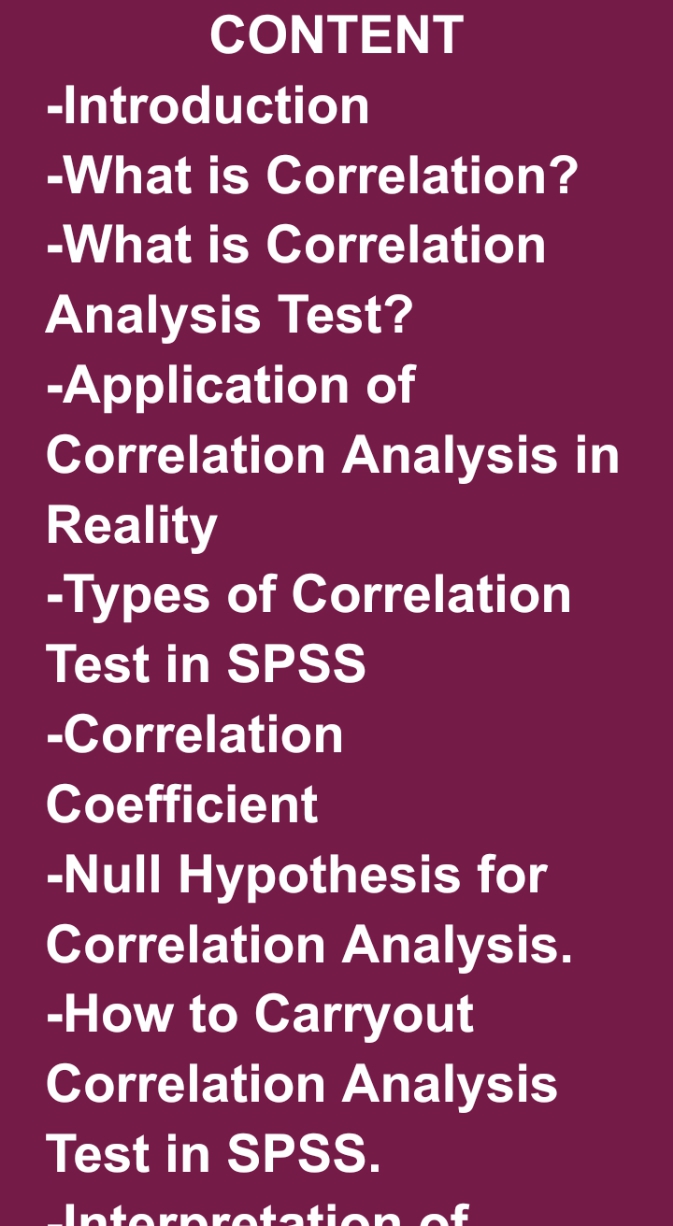CORRELATION ANALYSIS TEST IN SPSS

Correlation Test

Continuation

Contents
Introduction
What is Correlation?
What is Correlation Analysis Test?
Application of Correlation Analysis in Reality
Types of Correlation Test in SPSS
Correlation Coefficient
Null Hypothesis for Correlation Analysis.
How to Carryout Correlation Analysis Test in SPSS.
Interpretation of Correlation Result.
Conclusion.
Introduction
There are some variables in real life that seems to exist in pairs. In order words, they are related to each other. It may be observed that a slight increase in one variable will lead to an increase in the other variable vice versa. This has proven the existence of relationship between both variables.
However, correlation is not limited to only two variables but more.
Are you concerned about finding the relationship between two or more scale variables?
Correlation Analysis test guide is meant for you.
Just take a chill as I shall explain to the best of my knowledge, correlation test in SPSS through the grace of Jesus Christ.
What is Correlation?
Correlation is derived from two words namely co and relation. Co means two or more while relation is the effect of occurrence between things that are linked.
What is Correlation Analysis Test?
Correlation Analysis is a test carried out to find the linkage between two or more variables.
Hence it is the test of relationship to determine the strength of linkage between two or more variables.
Correlation Analysis test was introduced by a famous statistician named Karl person.
He invented a factor titled 'correlation coefficient' to determine the strength of linkage between two or more variables.
In order to apply correlation test, both variables must be of scale measurement.
Remember what we define a scale measurement as? It is a measurement indicating a value of measured quantity.
Application of Correlation Analysis test in Reality
The following are real life questions that can be answered by correlation test.
Does adult ages prompt the chances of getting rich?
When I was young, I had no money and I had this taught that all married people have money. Not until when I discovered that if you work, you will earn and information is wealth as well.
But before then, I had the question above in my mind due to the fact that all the people I've worked for that are adults had money.
In my question above both variables Such as age and wealth (income) can be measured and hence they are referred to as scale variables.
Does stress leads to depression?
If the scale of stress is measured on a scale from 1 - 100. Likewise depression, then you can consider running a correlation Analysis test.
This research was carried out in china in order to analyze the effect of diet consumption in seven schools. And the scale for stress and depression were measured.
Does high cost of petrol leads to increase in inflation?
This is also a question that involves correlation Analysis test in SPSS. I am interested in knowing if inflation arises as a result of high cost of petrol product.
We can see both are scale variables. The price of petrol is measured and has a value likwise the inflation level of product. We are concerned if the price of products gets increased as a result of increase in the price of petrol. There is a relationship between both variables.
These are the type of analysis a good leader should consider.
Types of correlation test in SPSS
The following are the types of correlation Analysis test in SPSS. I want us to visualize two variables, petrol price and inflation rate.
Positive correlation
Negative correlation
Positive correlation
Positive correlation test in SPSS entails increase in one variable will lead to an increase in the other variable. Hence the direction of relationship is positive and has a positive sign (+).
In positive correlation increase in petrol price will lead to increase in inflation rate. The relationship tends to the positive axis.
This statement shall be explained in details.
Negative correlation
Negative correlation entails that an increase in one variable will lead to a decrease in another variable that are related in a process.
A perfect example of negative correlation is the strength of a man and his age.
When a person is old enough, there won't strength any longer just like when the person was young.
Zero correlation
Zero correlation or correlation that tends towards zero in SPSS implies that there is a little or no relationship that exist between the variables.
Examples of such relationship is the number of men or women that passes on the street. There is no relationship at all.
Correlation coefficient

Correlation coefficient measures the degree to which variables are correlated. According to a statistican named Pearson , he used a number line to explain the coefficient of correlation better.
-1_____________0____________+1
When the correlation coefficient tends towards positive one we say that the variables are positively related meaning that increase in one will definitely lead to increase in the other.
When the coefficient tends towards zero we say that variables are not related in the universe.
When the it tends towards negative one, we say that variables are negatively correlated meaning an increase in one will lead to a decrease in the other.
Null hypothesis for correlation Analysis
As said earlier, every test has its null hypothesis, the null hypothesis for correlation analysis states that there is no relationship between the variables.
It is expected to use a significance value , usually 0.05 in order to compare with the hypothesis.
How to carryout correlation Analysis test in SPSS
To carry out correlation Analysis test in SPSS,
Go-to Analyze menu
Click on correlate
Select bivariate
Bivariate simply means two variables. Hence it can measure the strength of relationship between multiple variables in two's.
Drag the variable you wish to find the relationship into the variate box.
Select pearson and click ok.
Interpretation of correlation Analysis result
To interprete the result,
Identify the direction to which the Pearson correlation belongs as stated earlier.
It will either be positive, negative or zero.
Read the significance value and compared to a standard hypothesis.
If value > 0.05 accept the hypothesis
If value is < 0.05 reject hypothesis.
Hence state the directionality of the relationship.
Conclusion
Correlation does not mean one variable is the cause for increase or decrease in another. It only measures the strength of linkage or relationship.
Having read through, if there are questions, comments or suggestions as regards such will be highly appreciated.
Congratulations @iniobong3emm! You have completed the following achievement on the Hive blockchain and have been rewarded with new badge(s):
Your next target is to reach 4000 upvotes.
You can view your badges on your board and compare yourself to others in the Ranking
If you no longer want to receive notifications, reply to this comment with the word
STOPSupport the HiveBuzz project. Vote for our proposal!